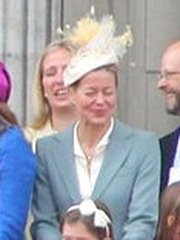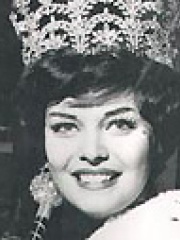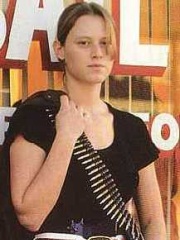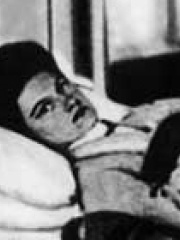
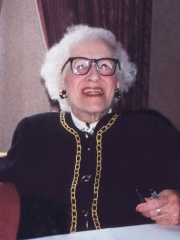
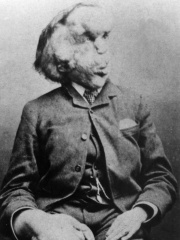
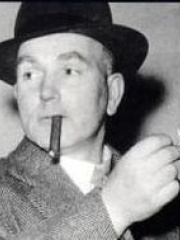

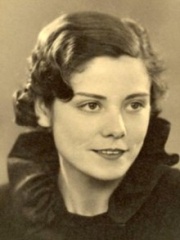
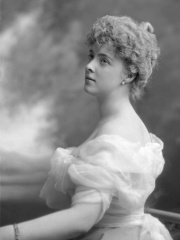
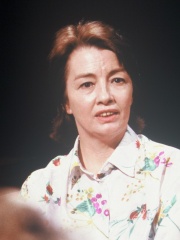
The Most Famous
CELEBRITIES from United Kingdom
This page contains a list of the greatest British Celebrities. The pantheon dataset contains 265 Celebrities, 17 of which were born in United Kingdom. This makes United Kingdom the birth place of the 2nd most number of Celebrities.
Top 10
The following people are considered by Pantheon to be the top 10 most legendary British Celebrities of all time. This list of famous British Celebrities is sorted by HPI (Historical Popularity Index), a metric that aggregates information on a biography's online popularity. Visit the rankings page to view the entire list of British Celebrities.

1. Mary Mallon (1869 - 1938)
With an HPI of 76.08, Mary Mallon is the most famous British Celebrity. Her biography has been translated into 42 different languages on wikipedia.
Mary Mallon (September 23, 1869 – November 11, 1938), commonly known as Typhoid Mary, was an Irish-born American cook who is believed to have infected between 51 and 122 people with typhoid fever. The infections caused three confirmed deaths, with unconfirmed estimates of as many as 50. She was the first person in the United States identified as an asymptomatic carrier of the pathogenic bacterium Salmonella typhi. She was forcibly quarantined twice by authorities, the second time for the remainder of her life because she persisted in working as a cook and thereby exposed others to the disease. Mallon died after a total of nearly 30 years quarantined. Her popular nickname has since become a term for persons who spread disease or other misfortune.

2. Millvina Dean (1912 - 2009)
With an HPI of 74.57, Millvina Dean is the 2nd most famous British Celebrity. Her biography has been translated into 47 different languages.
Eliza Gladys Dean (2 February 1912 – 31 May 2009), known as Millvina Dean, was a British civil servant, cartographer, and the last living survivor of the sinking of the RMS Titanic on 15 April 1912. At two months old, she was also the youngest passenger aboard.

3. Joseph Merrick (1862 - 1890)
With an HPI of 72.56, Joseph Merrick is the 3rd most famous British Celebrity. His biography has been translated into 44 different languages.
Joseph Carey Merrick (5 August 1862 – 11 April 1890) was an English man known for his severe physical deformities. He was first exhibited at a freak show under the stage name "The Elephant Man", and then went to live at the London Hospital, in Whitechapel, after meeting the surgeon Sir Frederick Treves. Despite his challenges, Merrick created detailed artistic works, such as intricate models of buildings, and became well known in London society. Merrick was born in Leicester and began to develop abnormally before the age of five. His mother died when he was eleven, and his father soon remarried. Rejected by his father and stepmother, he left home and went to live with his uncle, Charles Merrick. In 1879, 17-year-old Merrick entered the Leicester Union Workhouse. In 1884, he contacted a showman named Sam Torr and proposed that he might be exhibited. Torr arranged for a group of men to manage Merrick, whom they named "the Elephant Man". After touring the East Midlands, Merrick travelled to London to be exhibited in a penny gaff shop rented by showman Tom Norman. The shop was visited by surgeon Frederick Treves, who invited Merrick to be physically examined. Merrick was displayed by Treves at a meeting of the Pathological Society of London in 1884, after which Norman's shop was closed by the police. Merrick then joined Sam Roper's circus and then toured in Europe by an unknown manager. In Belgium, Merrick was robbed by his road manager and abandoned in Brussels. He eventually made his way back to the London Hospital, where he was allowed to stay for the rest of his life. Treves visited him daily, and the pair developed a close friendship. Merrick also received visits from some of the wealthy ladies and gentlemen of London society, including Alexandra, Princess of Wales. Merrick died in the hospital on 11 April 1890. Although the official cause of his death was asphyxia, Treves, who performed the postmortem, concluded that Merrick had died of a dislocated neck. The exact cause of Merrick's deformities is unclear, but in 1986 it was conjectured that he had Proteus syndrome. In a 2003 study, DNA tests on his hair and bones were inconclusive because his skeleton had been bleached numerous times before going on display at the Royal London Hospital. Merrick's life was depicted in a 1977 play by Bernard Pomerance and in a 1980 film by David Lynch, both titled The Elephant Man.

4. Albert Pierrepoint (1905 - 1992)
With an HPI of 64.76, Albert Pierrepoint is the 4th most famous British Celebrity. His biography has been translated into 24 different languages.
Albert Pierrepoint ( PEER-poynt; 30 March 1905 – 10 July 1992) was an English hangman who executed between 435 and 600 people in a 25-year career that ended in 1956. His father Henry and uncle Thomas were official hangmen before him. Pierrepoint was born in Clayton in the West Riding of Yorkshire. His family struggled financially because of his father's intermittent employment and heavy drinking. Pierrepoint knew from an early age that he wanted to become a hangman, and was taken on as an assistant executioner in September 1932, aged 27. His first execution was in December that year, alongside his uncle Tom. In October 1941 he undertook his first hanging as lead executioner. During his tenure he hanged 200 people who had been convicted of war crimes in Germany and Austria, as well as several high-profile murderers—including Gordon Cummins (the Blackout Ripper), John Haigh (the Acid Bath Murderer) and John Christie (the Rillington Place Strangler). He undertook several contentious executions, including Timothy Evans, Derek Bentley and Ruth Ellis and executions for high treason—William Joyce (also known as Lord Haw-Haw) and John Amery—and treachery, with the hanging of Theodore Schurch. In 1956 Pierrepoint was involved in a dispute with a sheriff over payment, leading to his retirement from the role of hangman. He ran a pub in Lancashire from the mid-1940s until the 1960s. He wrote his memoirs in 1974 in which he concluded that capital punishment was not a deterrent, although he may have changed his position subsequently. He approached his task with gravitas and said that the execution was "sacred to me". His life has been included in several works of fiction, such as the 2005 film Pierrepoint, in which he was portrayed by Timothy Spall.
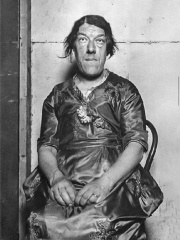
5. Mary Ann Bevan (1874 - 1933)
With an HPI of 62.97, Mary Ann Bevan is the 5th most famous British Celebrity. Her biography has been translated into 18 different languages.
Mary Ann Bevan (née Webster; 20 December 1874 – 26 December 1933) was an English nurse, who, after developing acromegaly, toured the circus sideshow circuit as "the ugliest woman in the world".

6. Alice Keppel (1868 - 1947)
With an HPI of 62.85, Alice Keppel is the 6th most famous British Celebrity. Her biography has been translated into 16 different languages.
Alice Frederica Keppel (née Edmonstone; 29 April 1868 – 11 September 1947) was an aristocrat, British society hostess and a long-time mistress of King Edward VII. Keppel grew up at Duntreath Castle, the family seat of the Edmonstone baronets in Scotland. She was the youngest child of Mary Elizabeth, née Parsons, and Sir William Edmonstone, 4th Baronet. In 1891 she married George Keppel, an army officer, and they had two daughters. Alice Keppel became one of the most prominent society hostesses of the Edwardian era. Her beauty, charm and discretion impressed London society and brought her to the attention of the future King Edward VII in 1898, when he was still Prince of Wales, and was his mistress until his death. Through her younger daughter, Sonia Cubitt, Alice Keppel is the great-grandmother of Queen Camilla, the former mistress and second wife of Edward VII's great-great-grandson King Charles III.

7. Barbara West (1911 - 2007)
With an HPI of 61.79, Barbara West is the 7th most famous British Celebrity. Her biography has been translated into 20 different languages.
Barbara Joyce Dainton (née West, 24 May 1911 – 16 October 2007) was the penultimate remaining survivor of the sinking of the Titanic on 14 April 1912 after hitting an iceberg on its maiden voyage. She was the last living survivor who travelled second-class on the ship.

8. Daisy, Princess of Pless (1873 - 1943)
With an HPI of 60.64, Daisy, Princess of Pless is the 8th most famous British Celebrity. Her biography has been translated into 17 different languages.
Daisy, Princess of Pless (born Mary Theresa Olivia Cornwallis-West; 28 June 1873 – 29 June 1943) was a noted society beauty in the Edwardian period. Daisy and her husband Prince Hans Heinrich XV von Hochberg were the owners of large estates and coal mines in Silesia (now in Poland) which brought an enormous fortune to the Hochbergs. During her marriage, she was a member of one of the wealthiest European noble families. She sought to prevent World War I by bringing together world leaders for peaceful discussions.

9. Christine Keeler (1942 - 2017)
With an HPI of 59.01, Christine Keeler is the 9th most famous British Celebrity. Her biography has been translated into 28 different languages.
Christine Margaret Keeler (22 February 1942 – 4 December 2017) was an English model and showgirl. Her meeting at a dance club with society osteopath Stephen Ward drew her into fashionable circles. At the height of the Cold War, she became sexually involved with a married British government minister, John Profumo, as well as with a Soviet naval attaché, Yevgeny Ivanov. A shooting incident involving a third lover caused the press to investigate her, revealing that her affairs could be threatening national security. In the House of Commons, Profumo denied any improper conduct but later admitted to having lied. This incident discredited the Conservative government of Harold Macmillan in 1963, in what became known as the Profumo affair. Keeler was alleged to have been a prostitute, which was not a criminal offence. Ward was, however, found guilty of being her pimp; a trial was instigated after the embarrassment caused to the government. The trial has since been considered a miscarriage of justice and a charade orchestrated by the establishment to protect itself.
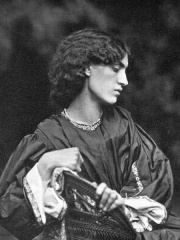
10. Jane Morris (1839 - 1914)
With an HPI of 58.59, Jane Morris is the 10th most famous British Celebrity. Her biography has been translated into 20 different languages.
Jane Morris (née Burden; 19 October 1839 – 26 January 1914) was an English embroiderer in the Arts and Crafts movement and an artists' model who embodied the Pre-Raphaelite ideal of beauty. She was a model and muse to her husband William Morris and to Dante Gabriel Rossetti. Her sister was the embroiderer and teacher Elizabeth Burden.
People
Pantheon has 17 people classified as British celebrities born between 1839 and 1999. Of these 17, 5 (29.41%) of them are still alive today. The most famous living British celebrities include Louise Brown, Brooklyn Beckham, and Lady Helen Taylor. The most famous deceased British celebrities include Mary Mallon, Millvina Dean, and Joseph Merrick. As of April 2024, 3 new British celebrities have been added to Pantheon including Lady Helen Taylor, Lord Frederick Windsor, and Lady Amelia Windsor.
Living British Celebrities
Go to all RankingsLouise Brown
1978 - Present
HPI: 51.98
Brooklyn Beckham
1999 - Present
HPI: 48.35
Lady Helen Taylor
1964 - Present
HPI: 45.32
Lord Frederick Windsor
1979 - Present
HPI: 39.92
Lady Amelia Windsor
1995 - Present
HPI: 34.75
Deceased British Celebrities
Go to all RankingsMary Mallon
1869 - 1938
HPI: 76.08
Millvina Dean
1912 - 2009
HPI: 74.57
Joseph Merrick
1862 - 1890
HPI: 72.56
Albert Pierrepoint
1905 - 1992
HPI: 64.76
Mary Ann Bevan
1874 - 1933
HPI: 62.97
Alice Keppel
1868 - 1947
HPI: 62.85
Barbara West
1911 - 2007
HPI: 61.79
Daisy, Princess of Pless
1873 - 1943
HPI: 60.64
Christine Keeler
1942 - 2017
HPI: 59.01
Jane Morris
1839 - 1914
HPI: 58.59
Rosemarie Frankland
1943 - 2000
HPI: 49.20
Domino Harvey
1969 - 2005
HPI: 46.39
Newly Added British Celebrities (2025)
Go to all RankingsLady Helen Taylor
1964 - Present
HPI: 45.32
Lord Frederick Windsor
1979 - Present
HPI: 39.92
Lady Amelia Windsor
1995 - Present
HPI: 34.75
Overlapping Lives
Which Celebrities were alive at the same time? This visualization shows the lifespans of the 11 most globally memorable Celebrities since 1700.



